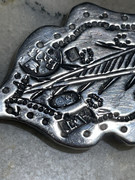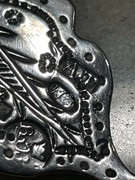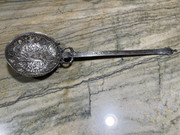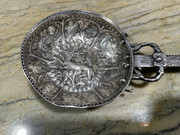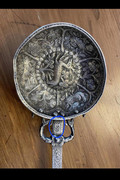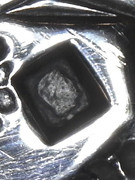Wine Ladle
-
mouseinstalled45
- Posts: 23
- Joined: Wed Sep 20, 2023 1:48 pm
Wine Ladle
Hello, I was wondering if anyone can provide some information on the maker of this piece? I'm trying to confirm the maker and exactly where it was made. I believe it could have been made in the Caucasus region. possibly made in Georgia? Any additional information would be great! It's about 14.5" long and weighs 209 grams. Thanks.
Re: Wine Ladle
Hello!
I see the mark of the Tiflis Mint (now the city of Tbilisi) - “ТМД” (first third of the 19th century) and the annual mark of 1830(?).
The state hallmark of this region from the 20th century with 84 hallmarks is also present.
I see the mark of the Tiflis Mint (now the city of Tbilisi) - “ТМД” (first third of the 19th century) and the annual mark of 1830(?).
The state hallmark of this region from the 20th century with 84 hallmarks is also present.
-
mouseinstalled45
- Posts: 23
- Joined: Wed Sep 20, 2023 1:48 pm
Re: Wine Ladle
Could you point out specifically which one is the Tiflis Mint or is it the “ТМД”?
-
mouseinstalled45
- Posts: 23
- Joined: Wed Sep 20, 2023 1:48 pm
Re: Wine Ladle
And which mark is the annual mark of 1830? Does that mean it was made then or early 20th?
Re: Wine Ladle
I wrote earlier that the "ТМД" mark existed in the first third of the 19th century. I think your product was made at that time. A hallmark with "84" may be a confirmation of the quality of the silver, because in the 1830s, the mark "84" was not used in Georgia.
-
mouseinstalled45
- Posts: 23
- Joined: Wed Sep 20, 2023 1:48 pm
Re: Wine Ladle
Ok, thank you. I just have no point of reference so I'm just trying to understand it all being from America this is all foreign to me and also fascinating.
-
mouseinstalled45
- Posts: 23
- Joined: Wed Sep 20, 2023 1:48 pm
Re: Wine Ladle
what do these marks mean? The "A.T" and "RC"
Re: Wine Ladle
"AT" is the hallmark of an assayer or silversmith. I have not studied this period in Georgia in detail.
The second mark is the annual mark (Georgian language) that has fallen on the right side.
The second mark is the annual mark (Georgian language) that has fallen on the right side.
Re: Wine Ladle
This is a mess! There are too many marks here in order to say anything with certainty. Like Mart wrote you have a Tiflis's mint punch from 1804-1832, but also a right looking kokshnik from 1907-1927 from Baku's region (O). Some kind of over stamping ?????? Summa summarum, what can be said is that it is made in the Baku region, that's about all sorry!
Re: Wine Ladle
I don’t understand why you suddenly started using the name of the city of Baku.
Any owner of a silver product at any time had the right to contact an assay office to check the quality of silver. It didn’t matter whether the silver product had any hallmarks or not.
Any owner of a silver product at any time had the right to contact an assay office to check the quality of silver. It didn’t matter whether the silver product had any hallmarks or not.
Re: Wine Ladle
Min my saying but, I wrote "Baku's region" not "city of Baku". Not quite the same, but in those days it was all imperial Russia. There is undoubtedly a long way from Baku to Tiflis, so ??? Anyway, the markings on the spoon are as said a mess! Moreover, there is a huge gap in years between the Tiflis's Mint punch and the kokshnik....??? It is also difficult to understand the existence of the kokoshnik punch. Not to mention what the other unclear punches show. I have no idea. Sorry.
Re: Wine Ladle
A bit more
I wrote Baku for this reason: Оmikron stands for Закавказское пробирное управление Бакинский губернский пробирев (Transcaucasian Assay Office Baku Provincial Assay Office). Anyway that doesn't explain the kokoshnik's existence.
I wrote Baku for this reason: Оmikron stands for Закавказское пробирное управление Бакинский губернский пробирев (Transcaucasian Assay Office Baku Provincial Assay Office). Anyway that doesn't explain the kokoshnik's existence.
Re: Wine Ladle
The Transcaucasian Assay Office was located in the city of Tiflis. There was only an assayer in the city of Baku. It was a branch.
Hallmarks from one period of the 1830s are on the item. Plus one stamp from 1908 and I have already written twice how it could have appeared. If the previous owner of the spoon wanted to check it, for example, in the middle of the 20th century, then the additional stamp “875” could have appeared there.
Hallmarks from one period of the 1830s are on the item. Plus one stamp from 1908 and I have already written twice how it could have appeared. If the previous owner of the spoon wanted to check it, for example, in the middle of the 20th century, then the additional stamp “875” could have appeared there.
Re: Wine Ladle
Yes, "could have and could have"... All in all, very little is fully clear in this case. What about the smudgy mark you also questioned (for a reason!) and ones again: I wrote Baku REGION not Baku town! Tiflis as well as Baku are both in the old Baku region!
As for me case clear.
As for me case clear.
-
mouseinstalled45
- Posts: 23
- Joined: Wed Sep 20, 2023 1:48 pm
Re: Wine Ladle
Mart wrote: ↑Sat Jan 13, 2024 4:39 am The Transcaucasian Assay Office was located in the city of Tiflis. There was only an assayer in the city of Baku. It was a branch.
Hallmarks from one period of the 1830s are on the item. Plus one stamp from 1908 and I have already written twice how it could have appeared. If the previous owner of the spoon wanted to check it, for example, in the middle of the 20th century, then the additional stamp “875” could have appeared there.
does this hallmark mean anything? I just cleaned it to reveal more..
-
mouseinstalled45
- Posts: 23
- Joined: Wed Sep 20, 2023 1:48 pm
Re: Wine Ladle
In accordance with the rules of 1908, this type of hallmark was used for certain types of gold items. The rhombus shape is for Russians, the square shape is for foreigners. I think that after the revolution and civil war these types of marks were used for reasons other than their original purpose. It is possible that the two hallmarks appeared on your item before 1927, when the hallmarking rules changed.
This is not Dmitry Tverskoy.
This is not Dmitry Tverskoy.
Re: Wine Ladle
Perhaps: "AT" is the mark of Alexander Trifonov.
